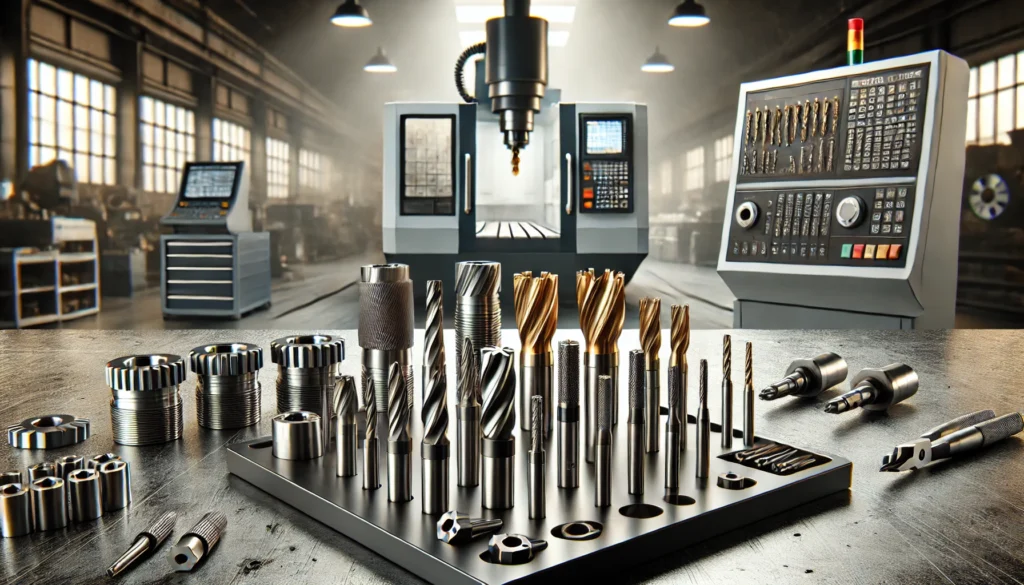Key Factors to Consider When Selecting Tooling for CNC and VMC

Tooling plays a critical role in CNC (Computer Numerical Control) and VMC (Vertical Machining Center) operations. The right tool not only ensures precision and efficiency but also extends tool life, reduces machining time, and improves surface finish. On the flip side, poor tooling choices can lead to excessive wear, vibration, and subpar quality.
So, how do you make the right tooling decisions for CNC and VMC machining? Let’s break it down into key factors you should consider.
1. Material of the Work piece
The type of material you’re machining dictates the kind of tooling required. Cutting mild steel is very different from cutting stainless steel, aluminium, titanium, or cast iron. Each material has unique properties that influence tool wear, heat generation, and cutting speeds.
Best practices:
- For aluminum – Use high-speed steel (HSS) or carbide tools with polished flutes to prevent built-up edge (BUE) formation.
- For hardened steel – Opt for coated carbide tools (TiAlN, TiCN) or even ceramic tools.
- For titanium and super alloys – Go with high-performance carbide tools with proper coatings to manage heat.
2. Tool Material and Coating
The material and coating of a cutting tool directly affect its performance and durability.
Common Tool Materials:
- High-Speed Steel (HSS) – Cost-effective but wears out faster in high-speed applications.
- Carbide – More expensive but offers better heat resistance and longer tool life.
- Ceramic & CBN (Cubic Boron Nitride) – Best for super-hard materials but require very stable cutting conditions.
Common Coatings:
- TiN (Titanium Nitride) – General-purpose coating that increases wear resistance.
- TiAlN (Titanium Aluminum Nitride) – Performs better at high temperatures, ideal for dry machining.
- Diamond Coatings – Used for machining graphite, composites, and highly abrasive materials.
3. Tool Geometry & Design
The shape and design of the tool impact chip evacuation, cutting forces, and tool stability.
Consider:
- Flute Count – Fewer flutes (2-3) work best for aluminum (better chip evacuation), while more flutes (4-6) suit harder materials for smoother finishes.
- Helix Angle – Higher helix angles (40-60°) help reduce cutting forces and vibration, while lower angles (30°) are more rigid.
- Corner Radius vs. Sharp Edges – A corner radius improves tool strength and surface finish, while sharp edges provide a cleaner cut but wear out faster.
4. Cutting Speeds & Feeds
Selecting the right speed and feed rate is crucial for maximizing tool life and achieving desired accuracy.
General rules:
- Too fast? The tool overheats, leading to premature wear or breakage.
- Too slow? You risk built-up edge formation, poor chip evacuation, and increased cutting forces.
- Best practice: Follow manufacturer recommendations and adjust based on real-time performance.
5. Tool Holding & Stability
Even the best cutting tool won’t perform well if not held securely.
Best Practices:
- For high-precision jobs: Hydraulic chucks or shrink-fit holders minimize run out.
- For general-purpose machining: ER collets are a cost-effective choice.
- For heavy-duty applications: Side-lock holders provide rigidity but may increase tool run out.
6. Coolant & Lubrication
Proper coolant application can extend tool life and improve surface finish.
Options:
- Flood Coolant – Great for heat dissipation in most machining applications.
- Minimum Quantity Lubrication (MQL) – Reduces waste while providing sufficient lubrication.
- Dry Machining – Works best with coated tools that can withstand high heat (e.g., TiAlN-coated tools).
7. Machining Application: Roughing vs. Finishing
Selecting the right tool depends on whether you’re removing bulk material (roughing) or achieving a fine surface finish (finishing).
- Roughing: Requires high-feed end mills or index able cutters to maximize material removal rates.
- Finishing: Needs sharp, high-flute end mills to achieve a smooth surface finish and dimensional accuracy.
Conclusion
Selecting the right tooling for CNC and VMC machining isn’t just about picking a tool off the shelf—it’s about optimizing performance, minimizing waste, and maximizing efficiency. By considering work piece material, tool composition, coatings, cutting parameters, tool holding, and cooling methods, you ensure better quality and cost-effectiveness.
At Qualicom, we understand that tooling plays a crucial role in machining success. Whether you need recommendations for high-precision CNC work or cost-effective solutions for bulk machining, we’re here to help! Get in touch with us today- contact@qualicom.in

